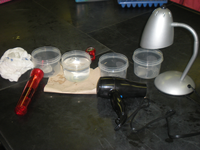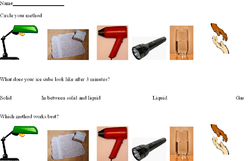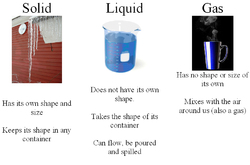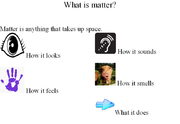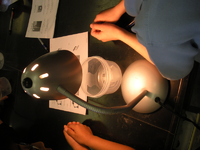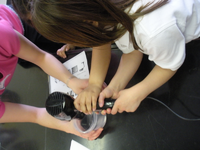Change Matters
| Instant wiki maker | Making handouts | Editing tips |
Biology In Elementary Schools is a Saint Michael's College student project from a course that ran between 2007 and 2010 and fully described in this book chapter. The student-created resources have been preserved here for posterity. Link under 'toolbox' for printer-friendly versions of the exercises. Click on handouts to print full resolution versions. Please see Wikieducator's disclaimer, our safety statement, and the Creative Commons licensing in English and in legalese.
Student worthiness
This activity has been used with several groups of first graders.
Primary biological content area covered
This experiment will teach students about the properties of matter and how the energy in heat can cause a solid to enter the liquid state.
Materials
- Plastic containers
- Ice cubes
- Water
- A hair dryer
- A desk lamp
- Flash light
- Pieces of cloth
- A cup of cold water
- Tea kettle
Note: Nearby source of electricity is required.
Handouts
There are three handouts for students use. The first handout is for students to record their observations during the experiment. The second handout defines the three states of matter. The final handout aids students when identifying states of matter.
Description of activity
This hands-on activity is designed to engage students' curiosity to experiment with changing matter. Students are challenged to turn ice to water (solid to liquid) using only the material given. Students will use what they have learned about heat and change in matter to have the liquid then become a gas.
Lesson plan
- Introduce the materials given for their challenge and the instructions
- Group students into pairs
- Allow the students sometime to come up with a plan with their partner, have them circle this option on their worksheets.
- Give each pair a container with one ice cube inside.
- After 3 minutes, ask the students to stop using their method.
- With their partner have them reflect on what has happened. Did the ice melt?
- Have students share their method and results with the group.
- What materials were most effective? Why do we think that was? Introduce the importance of heat in change of matter.
- Discuss student findings.
- Use a hot water kettle to boil water, and students will be able to see the steam as the water evaporates, and understand that a liquid changes to a gas when heat is added.
Potential pitfalls
In this activity, it is important to remind students that the sources of heat will be hot and to not touch them.
Math connections
The results can be posted in a graph, an average can be taken of the results, students could also measure temperature of the heat being used to melt the ice cube.
Literature connections
There are multiple books that children can explore during this lesoon which provide information about the states of matter. One we found helpful was:
- Garrett, Ginger. Solids, Liquids and Gases (Rookie Read-About Science). New York: Children's Press, 2005.
This is an interesting and informative book that explains the states of matter to young learners.
Connections to educational standards
S1-2:14 Students demonstrate their understanding of Physical Change by describing and reporting the change in properties when heat is applied to a solid or when heat leaves a liquid (e.g., water and ice).
Next steps
We found we had additional time so we took the opportunity to have a good discussion. We asked students to brainstorm where they have observed matter change in their daily lives. For example, students observe a stick of butter change into liquid when heat is added in a saucepan, or students observe snow change from a solid to liquid when the sun is warm enough to melt the snow. We encouraged the students to think of as many examples as they could, and this resulted in an interesting and informative discussion. These observations helped students to build a personally significant definition of states of matter.
Reflections
After trying this activity with first graders, we realized that most first graders did not have any prior knowledge about the states of matter, but when we prompted students to describe a solid and a liquid, they were able to describe both, as well as how a solid turns into a liquid. We found that it worked well to let students pick which method that they wanted to use to turn the ice cube into a liquid, and allow them to hypothesize why they chose the method that they did. It was interesting how many students chose to use their hands to melt the ice cube, and to watch their reactions as they realized that the warmth of their hands would melt the ice cube. One observation that we made was that it did not take long for students to melt the ice cubes, so there was more time to fill, but students only stayed engaged in a discussion for a short period of time after we finished the activity. We realized that we should have added another component to the activity which would take more time.
Citations and links
Idea originated from "Ice Cube Meltdown" from BrainPOP Jr. (http://www.brainpopjr.com/science/matter/changingstatesofmatter/grownups.weml)


